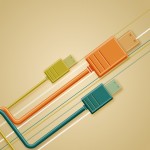
USB 2.0 and 1.1 devices have been around for a long time and will continue to sustain even in the presence of the new, faster and efficient 3.0 version. These two oldies, which I like to call legacy specification are so popular, that till 2008, 2 billion USB devices were sold every year, taking the total number to 6 billion devices (source Wikipedia); making USB the most successful computing interface of all time.
Computer hardware manufacturers are already gearing up to ship USB 3.0 devices and controllers in huge volumes. With 1 million PC sold each day in 2010, the PC market is booming and alarmingly spreading. This has set a perfect stage for USB 3.0 to become the mainstream of computing interfaces to replace USB 2.0.
But what about the 6 billion legacy devices and the older USB controllers. Would they connect to USB 3.0 devices?
The SuperSpeed USB specification has provisions for this backward compatibility. Also, USB 3.0 manufacturers cannot afford to not support the vast USB 2.0 user base. This means that USB 3.0 legacy compatibility will become critical.
Legacy compatibility testing with 6 billion devices is impossible, but we thought that practically it could be made simpler. We analyzed different USB use cases and identified five (5) different compatibility test nodes (highlighted in blue in the image).
- The devices segmented into 9 functional buckets
- The connectors / cables
- Intermediate hubs
- Controllers / add-on cards
- Operating system drivers
Combinations of these 5 testable areas would will yield compatibility test scenarios. But the scenario count will be pretty high, making it difficult to exercise. However, a careful and intelligent way of partitioning these test areas, can help achieve optimum number of test scenarios without loss of coverage.






